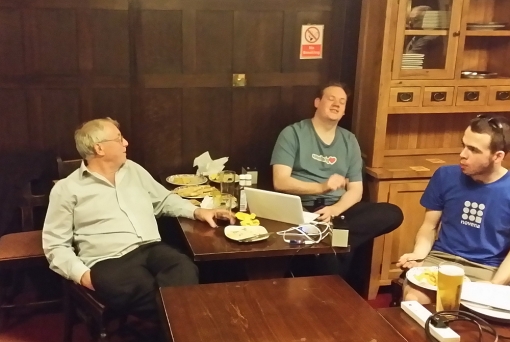Another activity this month – Roger Harris followed on his previous talk about how he’s using various systems to control all sorts of things around his home with a talk that focus in on the basics of making It talk to things. This is a long report – but it deserves to be.
Firstly a big thanks to Roger for doing this – I asked him to do it (and he showed the evidence, email screenshot to start with!) so those of us who were interested by the big picture given in his last talk and wanted to know where to start… wondered what do you do to get going.
Roger used an example of an Arduino, some goodies to connect up and a simple presentation. He started by showing an Arduino around – told us the various connectors and talked about the kind of things you can connect to them. He switched the screen to the programming interface, talked us through various sections of it and then worked through the led-flasher program, compiled it and uploaded it to the Arduino – the led flashed. So we have a blinking equivalent of ‘Hello world’ – he showed the variables that could be tweaked to alter the on or off time – demonstrating how blinking speed choice could give a dimming effect on the led – because leds don’t dim. (some one is going to pick me up on that I’m sure – I’ve been out of the electronics trade since 1997, that’s my excuse.)
Now Roger moved on – showed connecting an input, e.g. a switch up to the Arduino and programming it to react on switching – then in fine tutor fashion mixed the two programs up – now we could switch the led on and off.
The theory is that once have input and output controls we can begin to do more stuff with them – Roger demonstrated how the Arduino could be used to control another switch eg a relay – so now – we can use the Arduino to talk to some heavy duty gear while staying safely staying low voltage and tiny current itself. He had 4 relays clicking away and this is where things got more complicated – Roger had introduced timing elements into the program – so now he could do useful stuff.
He had the relays clicking timing by a program – and each relay could be connected to things like – water heaters, curtain closers, switching power source types (solar/wind/etc) – all dependant on what the input was doing. for example – eg a temperature sensor on the input and, for example, a fan to control the flow of warm air into a room. Now bolt more of other various things to control on – soon your house can scare visitors who don’t know it takes care of itself!
To finish Roger showed us I2C devices connected and told us how they extended the ability of the Arduino to control numbers of device from the physical limits by the one per pin-pair sensors demonstrated before. He showed how a program worked and explained addressing the devices – he had a program that listed connected I2C’s – then extracted one from the socket – it disapeared from listing on-screen, then replaced it – and it was re-added back into the circuit.
All great food for thought – again thanks Roger, your easy going style, managing to get so much over despite creating sporadic conversations as people realised what can be done. Then returning to the talk taking us to the next level of complication – at the end we were realising that many things got bolted together to make something very useful indeed.
Dave
Photos from the evening


I must say I really enjoyed the meeting. Roger’s delivery was clear and got the message over to the group. The room was full of people again which I also appriciate.. Hope to see you all there again next meeting!